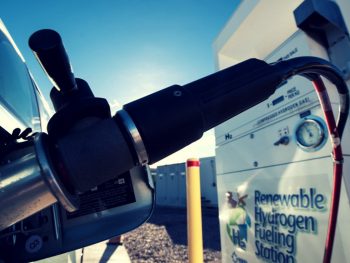The Government has revealed its plans for a “world-leading” hydrogen economy, helping to create jobs while decarbonising sectors such as heavy transport.

Underscoring commitments made in the 10 Point Plan for a green industrial revolution revealed last year, the strategy will enable government plans to deliver 5GW of low-carbon hydrogen production capacity by 2030.
This is the equivalent of replacing natural gas in powering around three million UK homes each year, but it will also be used to power transport and businesses, particularly heavy industry.
This will enable decarbonisation of polluting, energy-intensive industries such as chemicals, oil refineries and power, along with heavy transport like shipping, HGV lorries and trains; helping these sectors move away from fossil fuels.
According to government analysis, up to a third of the UK’s energy consumption by 2050 could be hydrogen-based and hydrogen power is seen as critical to meet our targets of net zero emissions by 2050 and cutting emissions by 78% by 2035.
In fact, a low-carbon hydrogen economy in the UK could deliver emissions savings equivalent to the carbon captured by 700 million trees by 2032.
The plans will also support more than 9,000 UK jobs and unlock £4bn investment by 2030, according to ministers.
Announcing the plans, Business & Energy Secretary Kwasi Kwarteng said: “Today marks the start of the UK’s hydrogen revolution. This home-grown clean energy source has the potential to transform the way we power our lives and will be essential to tackling climate change and reaching net zero.
“With the potential to provide a third of the UK’s energy in the future, our strategy positions the UK as first in the global race to ramp up hydrogen technology and seize the thousands of jobs and private investment that come with it.”
However, low-carbon hydrogen is more expensive to produce than fossil fuels and the Government has also launched a consultation to look at ways to overcome the cost gap. Its preferred hydrogen business model is built on a similar premise to the offshore wind Contracts for Difference (CfDs).
It’s also consulting on the design of the £240m Net Zero Hydrogen Fund, which aims to support the commercial deployment of new low-carbon hydrogen production plants across the UK.
Other measures included in the UK’s first-ever Hydrogen Strategy include:
- Outlining a ‘twin-track’ approach to supporting multiple technologies including ‘green’ electrolytic and ‘blue’ carbon capture-enabled hydrogen production, and committing to providing further detail in 2022 on the Government’s production strategy
- Collaborating with industry to develop a UK standard for low-carbon hydrogen, giving certainty to producers and users that the hydrogen produced by the UK is consistent with net zero while supporting the deployment of hydrogen across the country
- Undertaking a review to support the development of the necessary network and storage infrastructure to underpin a thriving hydrogen sector
- Working with industry to assess the safety, technical feasibility, and cost effectiveness of mixing 20% hydrogen into the existing gas supply. Doing so could deliver a 7% emissions reduction on natural gas
- Launching a hydrogen sector development action plan in early 2022 setting out how the Government will support companies to secure supply chain opportunities, skills and jobs in hydrogen.
In a move to prioritise and support polluting industries to significantly slash their emissions, the Government also announced today a £105m funding package through its Net Zero Innovation Portfolio that will act as a first step to build up Britain’s low-carbon hydrogen economy. The investment will help industries to develop low-carbon alternatives for industrial fuels, including hydrogen, which will be key to meeting climate commitments.
And the Transport Secretary also unveiled the winners of a £2.5m R&D competition for hydrogen transport pilots in the Tees Valley area, which will lead to supermarkets, emergency services and delivery companies trialling hydrogen-powered transport to move goods and carry out local services.
The reaction to the hydrogen strategy
The hydrogen strategy has been welcomed by ITM Power, which produces electrolyser systems for hydrogen generation. CEO Dr Graham Cooley said: “The industry needs a policy landscape in place that identifies priorities and support mechanisms for rolling out green hydrogen production in the UK and that’s just what today’s Hydrogen Strategy sets out.
“Green, zero-carbon hydrogen can abate greenhouse gas emissions from industry, transport and heat. It can be used to store our abundant renewable energy from offshore wind and longer term, be used to create export markets. This is a win for the UK’s decarbonisation plans, a win for cleaner air and a win for British jobs.”
However, the ‘twin-track’ approach to supporting both ‘green’ and ‘blue’ hydrogen has come under fire elsewhere. Green hydrogen schemes are based on electrolysis, with just oxygen as a byproduct, but blue hydrogen is produced from splitting natural gas and then capturing the carbon dioxide and storing it. As such, there are concerns that it could be actually more polluting than fossil fuels. According to a newly published study in the US, the carbon footprint to make blue hydrogen is more than 20% greater than either natural gas or coal.
Commenting on the Government’s plans, Friends of the Earth’s head of policy Mike Childs said: “Hydrogen has an important role in decarbonising some sectors, like steel. But only if it’s produced from renewable energy sources, and not so-called blue hydrogen, which is made using polluting gas. If the latter, then it’s business as usual because it’s yet more subsidies for the fossil fuel industry. If we are to avoid more climate chaos we have to stop the problem at source, not keeping adding to it and bailing out polluting industries to boot with taxpayer handouts.”

